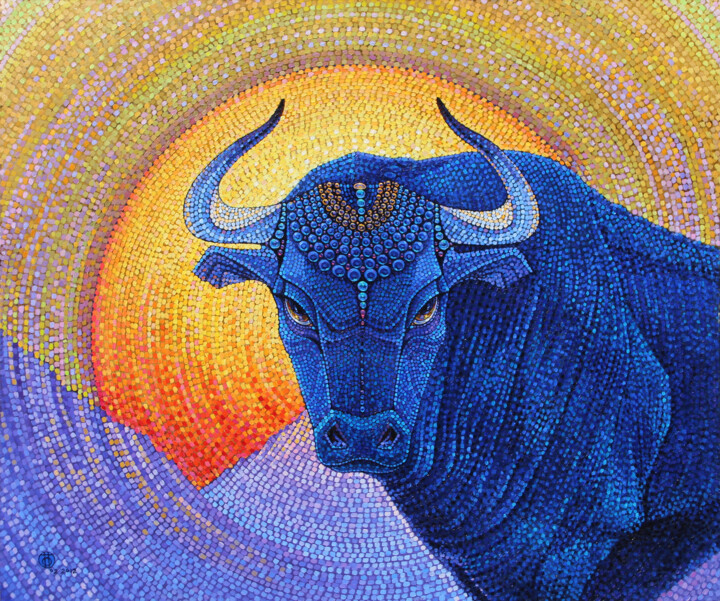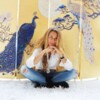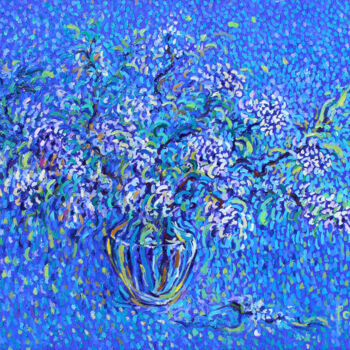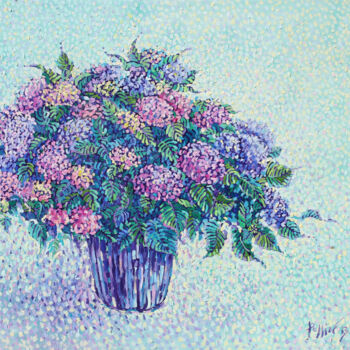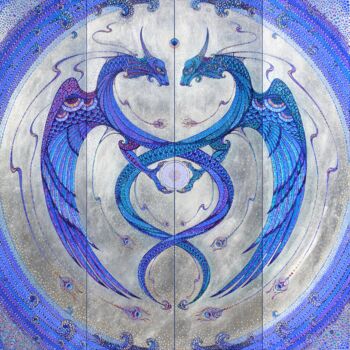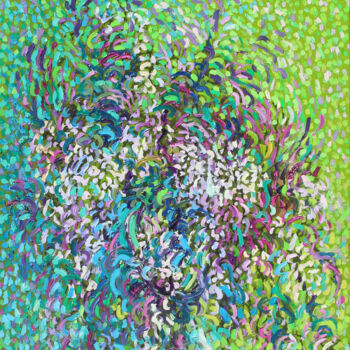TORO BLU-SHIVA (2012) Painting by Polina Ogiy
Sold by Polina Ogiy
This image is available for download with a licence
Sold by Polina Ogiy
-
Original Artwork (One Of A Kind)
Painting,
Oil
on Canvas
- Dimensions Height 39.4in, Width 47.2in
- Artwork's condition The artwork is in perfect condition
- Framing This artwork is not framed
- Categories Impressionism Esotericism
Он ждал,…держа на синих плечах,
Бессчетные миры, что разрушал,
Гася любовь и жизнь, как свечи.
Он знал, что смерть светила,
В себе таит уже рассвет.
Что разрушениям нет предела,
Как в созидании его нет.
И ощущение вечности тоскою,
Его пронзило, как всегда.
Нет в бесконечности покоя,
Лишь одиночество творца…..
Pollin 2012
Lord Shiva
Shiva is among the three main deities of Hinduism – Brahma, Vishnu and Shiva. All three gods are manifestations of the one divine essence, but each is assigned a specific "scope". So, Brahma is the Creator of the world, Vishnu its preserver, Shiva — its destroyer, but he recreates it again.The worship of Shiva originated during the time of the Dravidians – the indigenous inhabitants of Ancient India, Shiva who was the head of the main Pantheon of gods was the demiurge, the ruler of the world, as a model of a yogi has attained spiritual self-realization.
Trishul (Trident) in his right hand Shiva symbolizes the three gunas - sattva, rajas and Tamas. Through these three modes of Shiva controls the world. Damara (sacred drum), which is attached to a Trident, symbolizes the syllable "om", which consist of all languages. From the sounds of damaru Siva created the Sanskrit. The throat of Shiva's characteristic blue color. According to legend, Shiva swallowed the poison intended for the destruction of humanity and stopped him inside his throat and still keeps it there to prevent total destruction. The current of Ganga in the hair of Shiva represents the nectar of immortality, a Crescent in her hair denotes that Shiva full control of Your mind. Litter of tiger skin on which Shiva sits usually indicates defeated lust.
The body of Lord Shiva – white color- a symbol of spiritual purity. In the middle of His forehead is a third eye - the eye of wisdom can see through space and time. On the forehead of Shiva, the three stripes Bhasma – a symbol that Shiva destroyed the three pollution: anava (egoism), karma (consequences of past deeds) and Maya (illusion), and three of the desire to possess the land, woman and gold.
Snake on body of Shiva is Jiva (the personal soul), which rests on Siva. Five hoods represent the five senses or the five tattvas, namely, earth, water, fire, air and ether. Personal soul enjoys existing in a world of objects through the five tattvas. When the Jiva (the personal soul) by controlling the senses and the mind reaches knowledge, it finds its eternal safe refuge in Shiva, the Supreme Soul.
The usual seat of Shiva – mountain of Kailash in the Himalayas, where He made the dive. There Shiva, the embodiment of austerity, renunciation and detachment from the world. The third eye in the middle of His forehead indicates Its penetration into the secrets of the world. It expanded the audience for the blessing of the palm indicates that It liberates the Jiva (individual soul), burning all fetters leading to enlightenment.
In the cult of Shiva at the forefront of his creative – statues of the lingam in temples and home altars symbolize the life-giving potency of Shiva. In India they say: Shiva without Parvati (feminine energy) - He is Nirguna (devoid of qualities) Brahman (God). For the sake of pious devotees with Parvati He becomes Saguna-Brahman (with qualities). So manifested, dwells in the world of śiva is always accompanied by feminine energy. The Shiva Linga is always erect. Worship of śiva lingam is a phallic cult – Abhishek and Shiva-Puja.
Bull
bull, ox, Taurus lat. — Taurus
In some mythologies (Sumerian, Egyptian, etc.) found various connections of the ox and its corresponding mythological image: the identity, the bull as the earthly incarnation of God or as his attribute, etc. the Myths of the victory of the hero over the bull could be related to the ritual the ritual contest with the bull and sacrificing the sacred bull, which was widespread in the Eastern Mediterranean. In other myths of the same area the bull is a symbol of the God of storms (Hurrian, Slavic mythology). Perhaps the connection of the bull with the God of thunder goes back to an ancient Indo-European mythology. In Egyptian mythology, the bull of heaven — the son of the Celestial cow and the calf's father, whom she gives birth. These views are comparable bliznecy myths of some African peoples. Especially wide dissemination of the cult of the sacred bull (Buffalo) had in the ancient civilizations of the Indus valley (3rd Millennium BC), what allows to judge the seals from Mohenjo-Daro and Harappa and Sumerian information about people from the country Meluhha (India). The role of the bull as symbol of God (the bull the God Shiva Nandini) or as an enemy of the mythological hero (Skanda, who kills the spirit of a Buffalo in the mahābhārata, III, 221, 66; Valine, killing the Buffalo Dundubhi in Ramayana IV 11, 7-39) are characteristic of the elements of the ancient Indian mythology that can be associated with the earliest mondorescue its origins, continuing in mythological and religious conceptions such neitherpast peoples of southern India, as TOD (TOD is known the veneration and the sacrifice of a Buffalo as a sacred animal). The symbolism of the bull as the incarnation of the cosmic beginning, continuing a similar use of the symbol of a bison in the upper Palaeolithic art, characteristic of the Neolithic culture of Chatal-Chuuka (Asia Minor, 7-6 th century BC), where early layers (IX-VIA) found sculptural image of the ox, which used real cattle horns and part skull, which resembles the technique of "natural layout" of the beast in early cave art and technique of collage in contemporary art. In layer VI was found the bench, decorated with a line of bull horns. Almost in each of the sanctuaries (VII—II layers Chatal-Chuuka) has poles on which are placed the horns of the bulls. Such columns (later osmisljena as a way to scare away evil or to be a sign of evil in the house; Ms. bull's skull at Svan) is known, and much later in Asia Minor and in Crete, where the cult of the bull in many details coincides with the corresponding cult of the Chatal-Hyouka. Archaeological traces of cult of the bull can be traced in many ancient pastoralist cultures (according to some scholars, the cult wild bull played a significant role in the process of its domestication), influenced by Persian. A clay model of a temple, decorated with bull's horns, discovered in the settlement of Trypillya culture near the river ROS that gives rise to Parallels with the iconic role of the bull, bull horns and masks of a bull in the cultures of the Balkans 5-4 th centuries BC and in Chatal-houke. Ritual of the composition of several bull skulls are also found in such geographically and chronologically remote systems, as the burial ground Sintashta (the southern Ural, near the middle of the 2nd Millennium BC), in which found, and other traits common with Indo-European mythology. Where there was local cults of the main deities in the form of a bull, the temple was kept sacred bull as his incarnation (Egyptian APIs in Memphis); the beliefs of the Svans, bull Vishu, dedicated to the God Puttu, should be the most powerful and beautiful of the bulls. The bulls have (visible or invisible) sign of their belonging to a deity (similar to the designation of the bulls as "marked by God" occurs in grinenetsky tex
Related themes
CREDO Polina Ogiy
"Art is the creator soul delight spilled on canvas, embodied in marble, paper, notes in the form, line, color, sound, word, movement and thousands of other creative expressions. This is awareness of Genesis, understanding of the soul creating the fabric of life .
Works of art are true, pure symbols imprinted by the hand of the artist. They are characters of life, love, harmony and symmetry, sacred geometry of destiny. The world is ruled by symbols. And the true symbols express the divine harmony.If you're a creative person, the main energy that moves your hand is love, passion to cognition for the essence of things and phenomena. This is love and admiration, inspiration by the beauty of a landscape, character, object, myth or legend. The delight of my soul reflects the spiritual essence and symbolism of the Muse selected.Creativity is the destination of the soul incarnate in a person. We all are the co-creators of God, and everyone is an architect of his own life and world view. Convergence of matter and spirit, the ancient alchemy of human life are nothing else, but a splash of creative energy of spirit in matter.For me it is the music of my soul embodied in line and color, its trace through the time and space. Painting and sculpture are like my natural breath and my self expression. The motivation is simple - to live and create. An artist is the crystal, which stops the time in its purpose. An artist displays the Genesis, depicts the beauty and perfection of the moment. The artist perceives with his heart, not his eyes. An artist opens for the viewer the door to the wordlessness and guides to the pure original source of Life."
Polina Ogiy was born in Kharkov on 02/23/1977Education1984-1994 - piano school of music Kharkov1988-1992 Art School named after. I. E. Repina1994-1999 - Moscow State Academy of Art and Industry named after S. G. Stroganov (MGKhPA named after Stroganov)Diploma in Design.In 2004 Architectural Prize 2004 Moscow1996-2012Design studio "MONOPOLLY DESIGN" Moscow2012-2015Italy Pesaro Polina Ogiy Gallery “IL SOGNO”2017- Sicily Palermo.
2022 Pesaro Polina Ogiy Gallery “IL SOGNO”
1.The exhibition "Epoca del Sogno" Pesaro 2011 albergo Crueser
2.The exhibition "Epoca del Sogno" Pesaro 2011 albergo Alexsandr
3.The exhibition "Luce e ombra"galleria "IL SOGNO"22.08.2013
4.The exhibition "I volti del Buddha"galleria "IL SOGNO"11.07.2013
5.The exhibition "LE FIGLIE DI EVA"galleria "IL SOGNO"22.08.2012
6.The exhibition "VEDERE"galleria "IL SOGNO"24.04.2014
7.The exhibition "Alba in SICILIA"galleria "IL SOGNO"12.07.2014
8.The exhibition "Le tartarughe" galleria "IL SOGNO"12.07.2014
9.The exhibition personale Palazzo Consiglio regionale delle Marche Ancona 26.11.2014
10.The exhibition By the 10.04.2016-12.06.2016 the Gallery Poppi (AR), is hosting “De Naturarum Magnificentia”, a group exhibition curated by Sara Lovari and Silvia Rossi, in collaboration with ExpArt studio&gallery.
11. Premio internazionale Arte Milano 2017/07/25
-
Nationality:
UKRAINE

- Date of birth : unknown date
- Artistic domains: Works by professional artists,
- Groups: Professional Artist Ukrainian Contemporary Artists

